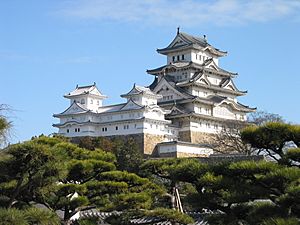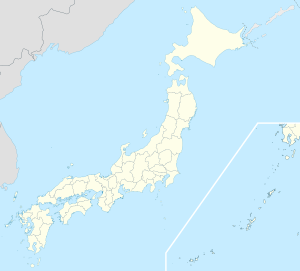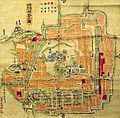Quick facts for kids Himeji Castle
姫路城 |
| Himeji, Hyōgo, Japan |
|
Himeji Castle in May 2015 after the five-year renovation of the roof and walls
|
|
|
| Coordinates |
34°50′22″N 134°41′38″E / 34.83944°N 134.69389°E / 34.83944; 134.69389 |
| Type |
Azuchi-Momoyama castle |
| Height |
46.4 m (152 ft) |
| Site information |
| Condition |
Intact, restoration work for preservation recently completed |
| Site history |
| Built |
- 1333, 1300 (Himeyama fort/castle)
- 1581 (expansion)
- 1601–1609 (expansion)
- 1617–1618 (expansion)
|
| Built by |
- Akamatsu Norimura (1333–1346)
- Toyotomi Hideyoshi (1581)
- Ikeda Terumasa (1601–1609)
- Honda Tadamasa (1617–1618)
|
| In use |
1333–1868-1945(as military camp) |
| Materials |
Wood, stone, plaster, tile |
| Demolished |
- 1346 (demolished for reconstruction)
- 1601–1609 (demolished for reconstruction)
|
| Garrison information |
| Garrison |
- ~500 (Ikeda family, soldiers)
- ~4,000 (Honda family, soldiers)
- ~3,000 (Sakakibara family, soldiers)
- ~2,200 (Sakai family, soldiers)
|
|
| UNESCO World Heritage Site |
| Criteria |
Cultural: i, iv |
| Inscription |
1993 (17th Session) |
| Area |
107 ha |
| Buffer zone |
143 ha |
|
Himeji Castle (姫路城) is a Japanese castle which is in Himeji in Hyōgo Prefecture. It includes 83 buildings made of wood. It is sometimes known as Hakurojō or Shirasagijō ("White Heron Castle") because of its brilliant white exterior.
It is a Japanese National Cultural Treasure. It is a UNESCO World Heritage Site.
Along with Matsumoto Castle and Kumamoto Castle, it is one of Japan's "Three Famous Castles", and is the most visited castle in Japan.
Several movies have been filmed at the castle, like Akira Kurosawa's Kagemusha and Ran; The Last Samurai starring Tom Cruise; and the Shogun 1980 TV-miniseries/movie starring Richard Chamberlain.
In 2009, Himeiji Castle was recognized as one of the 100 Landscapes of Japan which best show contemporary Japan and its culture in the Heisei period.
Related pages
Images for kids
-
Front view of the castle complex
-
A 1761 depiction of the castle complex
-
The "Three Country Moat" in the centre of the castle complex
-
A depiction of the intricate castle complex
-
The family crest of Ikeda Terumasa
-
Weapon racks inside the keep
-
-
Angled chutes or "stone drop windows"
-
"Diamond Gate", the first of the castle's 21 remaining gates
-
-
Keshō yagura (Dressing Tower) attributed to Senhime as part of her private chambers
-
A panoramic view of the castle grounds, with Himeji city in the background
-
The castle's keeps and city as seen from Engyō-ji
-
The castle complex as seen from the west
-
Keeps and bridge as seen from the entrance
-
A view of Keeps and the lush castle grounds below
-
Keeps as seen from the grounds below
-
One of the steep, narrow walkways controlling access to the castle
-
One of the steep castle walls
-
Himeji castle as seen from the princess quarters
-
The keep as seen from within the inner circle (本丸, honmaru)
-
Curved gables (千鳥破風, chidori hafu)
-
-
Himeji Castle view from below in May 2017
-
Castle walls and rooftops
-
-
The castle rooftops and surrounding city
-
Part of the intricate castle complex
-
A mythical tiger-headed fish called shachi (鯱). This motif was used atop the castle towers as a talisman for fire prevention.
-
A stone drop window (石落窓, ishi-otoshi-mado)
-
A window for an archer or defender using a Matchlock
-
An interior room with Tatami mats
-
-
-
Taken at Three Country Moats
-
-
-
-
Temporary cover and gantry
-
-
Different stages of applying plaster to the roof tiles. The plaster protects the roof from water ingress, and stops the tiles being dislodged by typhoon winds.
-
Roof structure underneath the tiles
-
View of the keep roof nearing completion, taken from the public view gallery.
-
-
-
See also
 In Spanish: Castillo Himeji para niños
In Spanish: Castillo Himeji para niños
 In Spanish: Castillo Himeji para niños
In Spanish: Castillo Himeji para niños















































